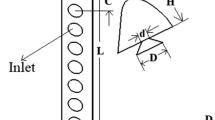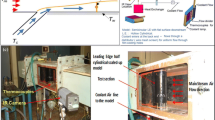Abstract
Impingement/effusion cooling is the most common cooling technique or the leading edge region of a gas turbine blade to increase the maximum allowable turbine inlet temperature and thermal efficiency. This study investigated the flow characteristics of jet impingement onto a concave target plate with effusion holes depending on the shape parameters using experimental and numerical analysis methods. The diameter of the injection plate and the arrangement of the effusion holes were varied at a jet Reynolds number of 5,000. The velocity fields were measured using the PIV technique in nine cases. The CFD results were validated through comparison with experimental results, and the 3D flow structures were estimated by computational fluid dynamics (CFD) simulations. The results are expected to provide knowledge for the design optimization of a cooling system to prevent the thermal load of the leading edge of gas turbine blades.
Graphical abstract














Similar content being viewed by others
Abbreviations
- Re :
-
Reynolds number [–]
- d i :
-
Diameter of injection hole [mm]
- d :
-
Diameter of effusion hole [mm]
- x i :
-
Cartesian coordinate [mm]
- u i :
-
Velocity component [m s−1]
- t :
-
Time [s]
- p :
-
Pressure [Pa]
- μ :
-
Dynamic viscosity [Pa·s]
- ρ :
-
Density [kg m−3]
- α :
-
Angle of streamlines [°]
- θ :
-
Angle of effusion holes [°]
- ω :
-
Vorticity [s−1]
- H :
-
Nozzle-to-plate distance [mm]
- U jet :
-
Time-averaged velocity [m ·s−1]
- Ū :
-
Jet exit velocity [m·s−1]
References
Achari AM, Das MK (2015) Application of various rans based models towards predicting turbulent slot jet impingement. Int J Therm Sci 98:332–351
Alekseenko SV, Antipin VA, Bobylev AV, Markovich DM (2007) Application of piv to velocity measurements in a liquid film flowing down an inclined cylinder. Exp Fluids 43:197–207
Andreini A, Cocchi L, Facchini B, Mazzei L, Picchi A (2018) Experimental and numerical investigation on the role of holes arrangement on the heat transfer in impingement/effusion cooling schemes. Int J Heat Mass Transfer 127:645–659
Ansys, I., Ansys fluent 12.0 user’s guide, New Hampshire: ANSYS INC, (2009), 35–47.
Andrews, G. E., Asere, A. A., Hussain, C. I., Mkpadi, M. C., and Nazari, A (1988) "Impingement/effusion cooling: Overall wall heat transfer." In ASME 1988 International Gas Turbine and Aeroengine Congress and Exposition, Volume 4: Heat Transfer; Electric Power; Industrial and Cogeneration
Ariz M, Huda N, Husain A (2015) Thermal performance analysis of jet impingement with effusion scheme. Procedia Engineering 127:110–117
Badran OO (1999) Gas-turbine performance improvements. Appl Energy 64:263–273
Bang M, Kim S, Park HS, Kim T, Rhee D-H, Cho HH (2021) Impingement/effusion cooling with a hollow cylinder structure for additive manufacturing: Effect of channel gap height. Int J Heat Mass Transf 175:121420
Bunker RS, Dees JE, Palafox P (2014) Impingement cooling in gas turbines: Design, applications, and limitations. Impingement Jet Cooling in Gas Turbines 25:1
Cho HH, Goldstein RJ (1995) Heat (mass) transfer and film cooling effectiveness with injection through discrete holes: Part i—within holes and on the back surface. J Turbomachinery 117(3):440–450. https://doi.org/10.1115/1.2835680
Cho HH, Kim BS (2014) Impingement/effusion cooling methods in gas turbine. Impingement Jet Cooling in Gas Turbines 25:125
Cho HH, Rhee DH (2001) Local heat/mass transfer measurement on the effusion plate in impingement/effusion cooling systems. J Turbomach 123:601–608
Cho H H, Rhee D Ho, Goldstein RJ (2008) Effects of hole arrangements on local heat/mass transfer for impingement/effusion cooling with small hole spacing. Journal of Turbomachinery. https://doi.org/10.1115/1.2812325
Committee, C. F. D. "Guide: Guide for the verification and validation of computational fluid dynamics simulations (aiaa g-077–1998 (2002))." American Institute of Aeronautics and Astronautics, Inc., 1998.
Fincham A, Delerce G (2000) Advanced optimization of correlation imaging velocimetry algorithms. Exp Fluids 29:S013–S022
Gau C, Chung CM (1991) Surface curvature effect on slot-air-jet impingement cooling flow and heat transfer process. Journal of Heat Transfer 113(4):858–864. https://doi.org/10.1115/1.2911214
Harris, S., and Smith, B. "Olive oil tracer particle size analysis for optical flow investigations in a gas medium." In APS Division of Fluid Dynamics Meeting Abstracts, R29. 009, 2014.
Hong Sung Kook, Rhee Dong-Ho, Cho Hyung Hee (2007) Effects of Fin Shapes and Arrangements on Heat Transfer for Impingement Effusion Cooling with Crossflow. J Heat Transfer 129(12):1697. https://doi.org/10.1115/1.2767727
Hong SK, Lee DH, Cho HH, Rhee D-H (2010) Local heat/mass transfer measurements on effusion plates in impingement/effusion cooling with rotation. Int J Heat Mass Transf 53:1373–1379
Jambunathan K, Lai E, Moss MA, Button BL (1992) A review of heat transfer data for single circular jet impingement. Int J Heat Fluid Flow 13:106–115
Jingzhou Z, Hao X, Chengfeng Y (2009) Numerical study of flow and heat transfer characteristics of impingement/effusion cooling. Chin J Aeronaut 22:343–348
Keith Walters D, Cokljat Davor (2008) A three-equation eddy-viscosity model for reynolds-averaged navier–stokes simulations of transitional flow. J Fluids Engineering. https://doi.org/10.1115/1.2979230
Kim KM, Moon H, Park JS, Cho HH (2014) Optimal design of impinging jets in an impingement/effusion cooling system. Energy 66:839–848
Kim M, Kim D, Yeom E (2020) Measurement of three-dimensional flow structure and transient heat transfer on curved surface impinged by round jet. Int J Heat Mass Transfer 161:120279
Langtry RB., Menter F, Likki S., Suzen Y., Huang P., and Volker, S (2006) A correlation-based transition model using local variables—part ii: Test cases and industrial applications,.
Lee HG, Kim J (2015) Two-dimensional kelvin–helmholtz instabilities of multi-component fluids. European Journal of Mechanics-B/fluids 49:77–88
Leweke T, Le Dizes S, Williamson CH (2016) Dynamics and instabilities of vortex pairs. Annu Rev Fluid Mech 48:507–541
Maghrabie HM (2021) Heat transfer intensification of jet impingement using exciting jets - A comprehensive review. Renewable and Sustainable Energy Reviews 139110684–S1364032120309680 110684. https://doi.org/10.1016/j.rser.2020.110684
Melling A (1997) Tracer particles and seeding for particle image velocimetry. Meas Sci Technol 8:1406
Menter FR (1994) Two-equation eddy-viscosity turbulence models for engineering applications. AIAA J 32:1598–1605
Menter FR, Langtry RB, Likki SR, Suzen YB, Huang PG, S. Volker, (2006) A correlation-based transition model using local variables—part i: Model formulation. Journal of Turbomachinery 128(3):413. https://doi.org/10.1115/1.2184352
Mishra, MP., Sahani A, Chandel S, and Mishra, R. (2018) Enhancement of full coverage film cooling effectiveness with mixed injection holes, International Journal of Turbo & Jet-Engines
Nobach H, Bodenschatz E (2009) Limitations of accuracy in piv due to individual variations of particle image intensities. Exp Fluids 47:27–38
Nogueira J, Lecuona A, Rodriguez P (2005) Limits on the resolution of correlation piv iterative methods. Fundamentals, Experiments in Fluids 39:305–313
Oberkampf WL, Trucano TG (2002) Verification and validation in computational fluid dynamics. Progress in Aerospace Sciences 38(3):209–272 S0376042102000052. https://doi.org/10.1016/S0376-0421(02)00005-2
Oguntade, H., Andrews, G., Burns, A., Ingham, D., and Pourkashanian, M. "Impingement/effusion cooling with low coolant mass flow." In Turbo Expo: Power for Land, Sea, and Air, 50893, V05CT17A004: American Society of Mechanical Engineers, 2017.
Philip J, Marusic I (2012) Large-scale eddies and their role in entrainment in turbulent jets and wakes. Phys Fluids 24:055108
Popiel CO, Trass O (1991) Visualization of a free and impinging round jet. Exp Thermal Fluid Sci 4:253–264
Rao Y, Liu Y, Wan C (2018) Multiple-jet impingement heat transfer in double-wall cooling structures with pin fins and effusion holes. Int J Therm Sci 133:106–119
Rhee DH, Choi JH, Cho HH (2003) Flow and heat (mass) transfer characteristics in an impingement/effusion cooling system with crossflow. J Turbomach 125:74–82
Sarno L, Carravetta A, Tai Y-C, Martino R, Papa M, Kuo C-Y (2018) Measuring the velocity fields of granular flows–employment of a multi-pass two-dimensional particle image velocimetry (2d-piv) approach. Adv Powder Technol 29:3107–3123
Scarano F, Riethmuller ML (1999) Iterative multigrid approach in piv image processing with discrete window offset. Exp Fluids 26:513–523
Shih T-H, Liou WW, Shabbir A, Yang Z, Zhu J (1995) A new k-ϵ eddy viscosity model for high reynolds number turbulent flows. Comput Fluids 24:227–238
Singh P, Ekkad SV (2017) Effects of spent air removal scheme on internal-side heat transfer in an impingement-effusion system at low jet-to-target plate spacing. Int J Heat Mass Transf 108:998–1010
Sodja, J., Turbulence models in cfd, University of Ljubljana, (2007), 1–18.
Thielicke W (2014) The flapping flight of birds. University of Groningen, Diss
Thielicke W, Stamhuis E J (2014) PIVlab – Towards User-friendly, Affordable and Accurate Digital Particle Image Velocimetry in MATLAB. Journal of Open Research Software. https://doi.org/10.5334/jors.bl
Thielicke W, and Sonntag R (2021). Particle image velocimetry for matlab: Accuracy and enhanced algorithms in pivlab, Journal of Open Research Software, 9,
Wei-Hua Y, Jun C, Rui S, Xu-Sheng H, Shuang-Wen S (2011) Experimental investigation on impingement-effusion film-cooling behaviors in curve section. Acta Astronaut 68:1782–1789
Xie G, Liu C-L, Ye L, Wang R, Niu J, Zhai Y (2020) Effects of impingement gap and hole arrangement on overall cooling effectiveness for impingement/effusion cooling. Int J Heat Mass Transf 152:119449
Yeom E, Nam K-H, Paeng D-G, Lee SJ (2014) Improvement of ultrasound speckle image velocimetry using image enhancement techniques. Ultrasonics 54:205–216
Zhou J, Wang X, Li J, Li Y (2018) Effects of film cooling hole locations on flow and heat transfer characteristics of impingement/effusion cooling at turbine blade leading edge. Int J Heat Mass Transf 126:192–205
Zuiderveld Karel (1994) Contrast limited adaptive histogram equalization. Graphics gems. Elsevier, pp 474–485. https://doi.org/10.1016/B978-0-12-336156-1.50061-6
Acknowledgements
This work was supported by the National Research Foundation of Korea(NRF) grant funded by the Korea government(MSIT) (No. 2020R1A5A8018822 and 2021R1I1A3047664).
Author information
Authors and Affiliations
Corresponding author
Additional information
Publisher's Note
Springer Nature remains neutral with regard to jurisdictional claims in published maps and institutional affiliations.
Supplementary Information
Below is the link to the electronic supplementary material.
Rights and permissions
Springer Nature or its licensor holds exclusive rights to this article under a publishing agreement with the author(s) or other rightsholder(s); author self-archiving of the accepted manuscript version of this article is solely governed by the terms of such publishing agreement and applicable law.
About this article
Cite this article
Seo, H., Kwon, D., Lee, S. et al. Experimental and numerical investigation of the effects of the jet diameter and arrangement of effusion holes on the concave surface of an impingement/effusion cooling system. J Vis 26, 61–81 (2023). https://doi.org/10.1007/s12650-022-00869-0
Received:
Revised:
Accepted:
Published:
Issue Date:
DOI: https://doi.org/10.1007/s12650-022-00869-0




